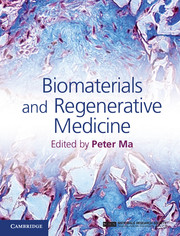Book contents
- Frontmatter
- Contents
- List of contributors
- Preface
- Part I Introduction to stem cells and regenerative medicine
- Part II Porous scaffolds for regenerative medicine
- Part III Hydrogel scaffolds for regenerative medicine
- Part IV Biological factor delivery
- Part V Animal models and clinical applications
- 25 Bone regeneration
- 26 Biomaterials for engineered tendon regeneration
- 27 Advancing articular cartilage repair through tissue engineering: from materials and cells to clinical translation
- 28 Engineering tissue-to-tissue interfaces
- 29 Models of composite bone and soft-tissue limb trauma
- 30 Tooth development and regeneration
- 31 Dentin–pulp tissue engineering and regeneration
- 32 Dental enamel regeneration
- 33 Hair follicle and skin regeneration
- 34 In-vitro blood vessel regeneration
- 35 Stem cells for vascular engineering
- 36 Cardiac tissue regeneration in bioreactors
- 37 Bladder regeneration
- Index
- References
28 - Engineering tissue-to-tissue interfaces
from Part V - Animal models and clinical applications
Published online by Cambridge University Press: 05 February 2015
- Frontmatter
- Contents
- List of contributors
- Preface
- Part I Introduction to stem cells and regenerative medicine
- Part II Porous scaffolds for regenerative medicine
- Part III Hydrogel scaffolds for regenerative medicine
- Part IV Biological factor delivery
- Part V Animal models and clinical applications
- 25 Bone regeneration
- 26 Biomaterials for engineered tendon regeneration
- 27 Advancing articular cartilage repair through tissue engineering: from materials and cells to clinical translation
- 28 Engineering tissue-to-tissue interfaces
- 29 Models of composite bone and soft-tissue limb trauma
- 30 Tooth development and regeneration
- 31 Dentin–pulp tissue engineering and regeneration
- 32 Dental enamel regeneration
- 33 Hair follicle and skin regeneration
- 34 In-vitro blood vessel regeneration
- 35 Stem cells for vascular engineering
- 36 Cardiac tissue regeneration in bioreactors
- 37 Bladder regeneration
- Index
- References
Summary
Introduction
Orthopedic injuries and diseases commonly affect soft tissues, including cartilage, which line the surface of articulating joints, as well as ligaments and tendons, which connect bone to bone and muscle to bone, respectively. Continued developments in tissue engineering have led to advancements in the regeneration of these tissues, while recently emphasis has been placed on the regeneration of the interfaces or insertion sites that connect these soft tissues to bone, which are characterized by a gradient of structural and mechanical properties [1]. The integrity of these regions is essential to facilitating synchronized joint motion, mediating load transfer between distinct tissue types, and sustaining heterotypic cellular communications necessary for interface function and homeostasis [2–4]. These critical junctions are also prone to injury, and healing is typically incomplete after surgical repair. The need for functional interface regeneration is highlighted by the fact that failure to restore the intricate tissue-to-tissue interface has been reported to compromise graft stability and long-term clinical outcome [5, 6].
Fundamentally, tissue engineering involves the use of cells, growth factors, and/or biomaterial scaffolds in a variety of ways to engineer tissues in vitro and in vivo. The principles of tissue engineering have been applied for the successful formation of connective tissues, including bone, cartilage, ligament, and tendon. Recently the focus in the field has shifted from tissue formation to tissue function [7], specifically to imparting physiologically relevant functionality to tissue-engineered grafts. One of the most significant challenges to clinical application is achieving biological fixation of musculoskeletal grafts with each other as well as to the native host environment [8].
- Type
- Chapter
- Information
- Biomaterials and Regenerative Medicine , pp. 514 - 533Publisher: Cambridge University PressPrint publication year: 2014



